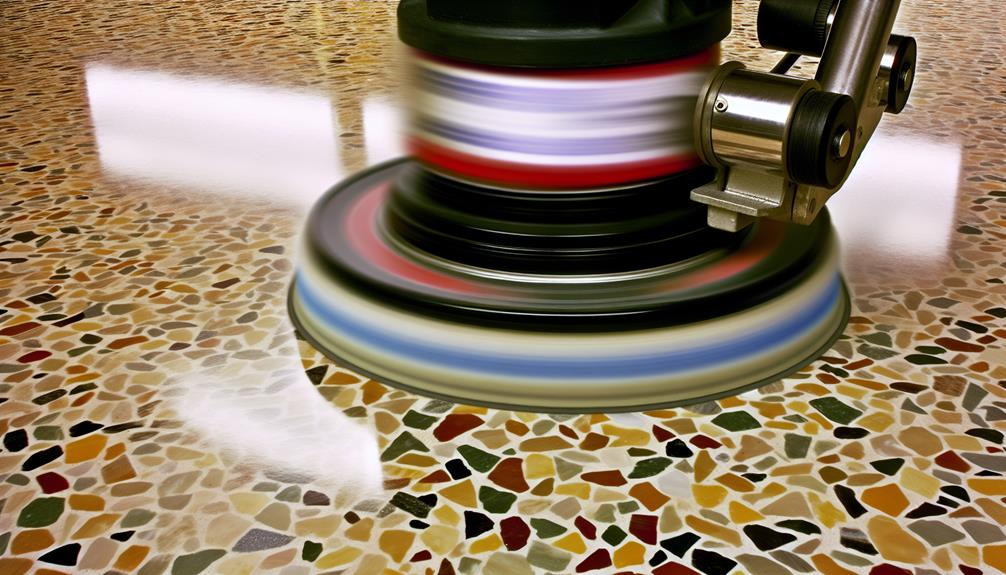You may think you've got terrazzo polishing down, but are you truly mastering the techniques? From the initial surface preparation to the final buffing, there's a world of intricate details awaiting you in the realm of achieving that perfect shine. Let's explore how the right tools, knowledge of aggregates, and precise execution can elevate your terrazzo polishing game to the next level. Get ready to unlock the secrets that will transform your terrazzo floors into stunning works of art.
Key Takeaways
Contents
- 1 Key Takeaways
- 2 Essential Equipment for Terrazzo Polishing
- 3 Understanding Different Terrazzo Aggregates
- 4 Preparing the Terrazzo Surface
- 5 Choosing the Right Polishing Pads
- 6 Mastering the Polishing Techniques
- 7 Troubleshooting Common Polishing Issues
- 8 Maintaining the Polished Terrazzo Surface
- 9 Frequently Asked Questions
- Start with a clean surface to ensure optimal results.
- Use progressively higher grit pads for a refined finish.
- Maintain consistent pressure and speed for even polishing.
- Adjust machine settings for specific terrazzo needs.
- Troubleshoot issues like swirl marks or hazing for quality results.
Essential Equipment for Terrazzo Polishing
To effectively master terrazzo polishing, having the right equipment is essential.
The key to achieving a high-quality finish lies in using specialized tools designed for terrazzo surfaces. Start with a heavy-duty terrazzo grinder equipped with diamond polishing pads. These pads come in varying grit levels, from coarse to fine, to help you achieve the desired level of smoothness and shine.
Additionally, a wet/dry vacuum is crucial for keeping the work area clean and free of debris during the polishing process.
You will also need a set of terrazzo sealers to protect the surface and enhance its durability. Make sure to choose a high-quality sealer that's compatible with your specific terrazzo type.
A terrazzo floor burnisher is essential for the final polishing stages, providing a glossy finish that enhances the beauty of the terrazzo. Lastly, don't forget to invest in personal protective equipment such as goggles, gloves, and a dust mask to ensure your safety while working with these powerful tools.
With the right equipment and proper technique, you'll be on your way to mastering terrazzo polishing techniques.
Understanding Different Terrazzo Aggregates
Understanding different terrazzo aggregates is crucial for achieving desired aesthetic results in terrazzo flooring.
The choice of aggregates significantly impacts the final appearance and performance of terrazzo surfaces. Marble chips are a popular option, offering a classic, elegant look with various color options.
For a more contemporary finish, consider glass or mother of pearl aggregates that provide a unique, reflective quality. Recycled aggregates can also be used for an eco-friendly approach, adding character and sustainability to the flooring.
Each type of aggregate has its own characteristics, affecting the overall texture, durability, and visual appeal of the terrazzo.
It's essential to consider factors like size, shape, color, and hardness when selecting aggregates to ensure they complement the design vision and meet the project requirements.
Understanding how different aggregates interact with the binding matrix is key to creating a cohesive and visually stunning terrazzo floor that stands the test of time.
Preparing the Terrazzo Surface
Regularly assessing the terrazzo surface before polishing is essential to ensure a successful outcome.
Begin by thoroughly cleaning the surface to remove any dirt, dust, or debris. Inspect the terrazzo for any cracks, holes, or chips that need to be repaired before proceeding. Use a suitable filler to fix these imperfections, ensuring a smooth and level surface.
Next, evaluate the overall condition of the terrazzo to determine if any stubborn stains or discoloration need special attention. Address these issues using appropriate cleaning solutions and techniques.
After the surface is clean and all repairs are completed, it's crucial to profile the terrazzo. Profiling involves roughening the surface to promote better adhesion of the polishing pads. This can be done using diamond abrasives or other profiling tools.
Choosing the Right Polishing Pads
Ensuring you choose the right polishing pads is a critical step in achieving a high-quality finish when polishing terrazzo surfaces. The type of polishing pad you select can significantly impact the final result, so it's essential to understand the different options available. Here is a detailed breakdown of various polishing pads commonly used in terrazzo polishing:
| Pad Type | Description |
|---|---|
| Metal Bond | Aggressive pads for grinding and removing tough stains. |
| Resin Bond | Versatile pads suitable for honing and polishing. |
| Hybrid | Combines metal and resin for a balanced approach. |
| Transitional | Ideal for transitioning between metal and resin pads. |
| Polishing | Provides the final polish and shine to the terrazzo surface. |
Each pad serves a specific purpose in the terrazzo polishing process, from initial grinding to the final polish. By selecting the right combination of pads and using them effectively, you can achieve a flawless finish that enhances the beauty of the terrazzo surface.
Mastering the Polishing Techniques
Mastering the polishing techniques for terrazzo surfaces requires a combination of skill, precision, and understanding the nuances of the process.
To achieve a flawless finish, begin by ensuring the surface is clean and free of any debris. Start the polishing process by using a low-grit diamond pad to remove any imperfections or existing coatings.
Move on to higher-grit pads gradually to refine the surface and enhance its shine. It's essential to maintain a consistent pressure and speed while polishing to avoid uneven results.
Utilize a quality terrazzo polishing machine with adjustable settings to tailor the process to the specific needs of the surface.
Keep the machine moving in a steady back and forth motion to prevent over-polishing in one spot. Pay close attention to the edges and corners, as they require special care to achieve a uniform finish.
Troubleshooting Common Polishing Issues
Addressing common polishing issues is crucial for achieving professional results when working with terrazzo surfaces.
One common problem is swirl marks appearing during the polishing process. This issue can often be resolved by adjusting the pressure on the machine or by using a different polishing pad.
If you encounter hazing or a dull appearance on the terrazzo surface after polishing, it may be due to using the wrong type of polishing compound. Switching to a finer compound and adjusting the polishing process can help restore the shine.
Inconsistent gloss levels across the terrazzo floor can be a result of uneven polishing or improper application of the polishing compound. Make sure to maintain a consistent speed and pressure while polishing to achieve uniform gloss.
Lastly, if you notice scratches on the terrazzo surface after polishing, consider using a finer grit polishing pad or addressing any underlying issues with the surface before proceeding. Mastering troubleshooting techniques for common polishing problems will elevate the quality of your terrazzo work.
Maintaining the Polished Terrazzo Surface
To effectively maintain the polished terrazzo surface, it is essential to establish a regular cleaning routine that preserves its shine and longevity. By following a few simple steps, you can keep your terrazzo floors looking pristine for years to come. Here are some expert tips for maintaining your polished terrazzo surface:
| Cleaning Method | Frequency |
|---|---|
| Sweep or vacuum | Daily |
| Damp mop with pH-neutral cleaner | Weekly |
| Buff with a polishing compound | Monthly |
Sweeping or vacuuming daily removes dirt and debris that can scratch the surface. Damp mopping weekly with a pH-neutral cleaner helps to clean without damaging the polish. For added shine, consider buffing with a polishing compound on a monthly basis. By incorporating these maintenance tasks into your cleaning routine, you can ensure that your polished terrazzo surface remains beautiful and lustrous.
Frequently Asked Questions
Can Terrazzo Polishing Be Done on Outdoor Surfaces?
Yes, you can polish terrazzo surfaces outdoors. Ensure the terrazzo mix is suitable for outdoor use, apply a proper sealer to protect against the elements, and use diamond polishing pads designed for exterior terrazzo to achieve a durable finish.
How Long Do Polished Terrazzo Floors Typically Last?
Polished terrazzo floors typically last for decades when properly maintained. The longevity depends on factors like foot traffic, maintenance routine, and sealant quality. With regular care and upkeep, your polished terrazzo floors can maintain their shine and durability for a long time.
Can Terrazzo Polishing Be Done on Vertical Surfaces?
Yes, absolutely! Terrazzo polishing can indeed be performed on vertical surfaces, like walls and stairs. It requires specialized tools and techniques, but with practice and precision, you can achieve stunning results that elevate the aesthetic appeal of any space.
Is It Possible to Polish Terrazzo Without Professional Help?
Yes, you can polish terrazzo without professional help. Begin by cleaning the surface thoroughly. Use a terrazzo polishing machine with the appropriate pads and compounds. Practice proper technique and follow safety guidelines for optimal results.
How Does Humidity Affect the Terrazzo Polishing Process?
Humidity impacts terrazzo polishing by affecting the drying time of sealers and polishers. High humidity can slow down the process, leading to longer curing times and potential streaking. Adjust ventilation and use dehumidifiers to control humidity levels for optimal results.

